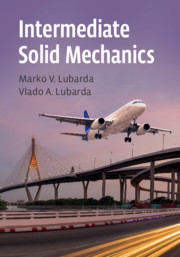Book contents
- Frontmatter
- Contents
- Preface
- Part I Fundamentals of Solid Mechanics
- Part II Applications
- 6 Two–Dimensional Problems of Elasticity
- 7 Two–Dimensional Problems in Polar Coordinates
- 8 Antiplane Shear
- 9 Torsion of Prismatic Rods
- 10 Bending of Prismatic Beams
- 11 Contact Problems
- 12 Energy Methods
- 13 Failure Criteria
- Further Reading
- Index
12 - Energy Methods
from Part II - Applications
Published online by Cambridge University Press: 16 December 2019
- Frontmatter
- Contents
- Preface
- Part I Fundamentals of Solid Mechanics
- Part II Applications
- 6 Two–Dimensional Problems of Elasticity
- 7 Two–Dimensional Problems in Polar Coordinates
- 8 Antiplane Shear
- 9 Torsion of Prismatic Rods
- 10 Bending of Prismatic Beams
- 11 Contact Problems
- 12 Energy Methods
- 13 Failure Criteria
- Further Reading
- Index
Summary
The expressions for the elastic strain energy and its volumetric and deviatoric parts are derived for three-dimensional states of stress and strain. Betti's reciprocal theorem of linear elasticity is formulated, which yields the Maxwell coefficients, frequently used in structural mechanics. Castigliano's theorem is formulated and applied to axially loaded rods and trusses, twisted bars, and bent beams and frames. The principle of virtual work and the variational principle of linear elasticity are introduced. The differential equation of the deformed shape of the bent beam is derived from the consideration of the principle of virtual work. The approximate Rayleigh–Ritz method is introduced and applied to selected problems of structural mechanics. An introduction to the finite element method in the analysis of beam bending, torsion, and axial loading is then presented. The corresponding stiffness matrices and load vectors are derived for each element and are assembled into the global stiffness matrix and load vector of the entire structure.
Keywords
- Type
- Chapter
- Information
- Intermediate Solid Mechanics , pp. 386 - 437Publisher: Cambridge University PressPrint publication year: 2020



